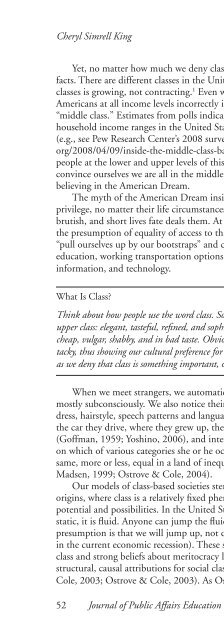WINTER 2012 - National Association of Schools of Public Affairs and ...
WINTER 2012 - National Association of Schools of Public Affairs and ...
WINTER 2012 - National Association of Schools of Public Affairs and ...
You also want an ePaper? Increase the reach of your titles
YUMPU automatically turns print PDFs into web optimized ePapers that Google loves.
Amy E. Smith <strong>and</strong> Ignacio J. Martinez-Moyano<br />
quantitatively trained personnel will continue to grow (Colwell & Kelly, 1999;<br />
Dawes, 2004; de Libero, 2005; Lane, Mansour, & Harpell, 1993; Philip &<br />
Shultz, 1994; Vijverberg, 1997). Traditional methods <strong>of</strong> teaching introductory<br />
statistics courses are <strong>of</strong>ten viewed as ineffective (Peiris, 2002; Schacht &<br />
Aspelmeier, 2005; Yilmaz, 1996; Zanakis & Valenzi, 1997), resulting in student<br />
anxiety about coursework, a perception that statistics is too difficult, <strong>and</strong> failure<br />
to persuade students that statistics is relevant to their careers (Davis, 2003;<br />
Forte, 1995; Zanakis & Valenzi, 1997). Thus, although statistics is commonly<br />
necessary in real-world work, there is a perceived gap between research <strong>and</strong><br />
practice (Shapiro, Kirkman, & Courtney, 2007). Ultimately, practitioners remain<br />
quantitatively underprepared for their jobs.<br />
The existence <strong>of</strong> a gap between research <strong>and</strong> practice means that practitioners<br />
are not using research that might assist them in making better decisions, <strong>and</strong><br />
researchers may not be producing high-quality research that has relevance for<br />
practitioners (Adams & White, 1994; Calderwood, 2002; Duncan, 1974;<br />
Felbinger, Holzer, & White, 1999; Fitzpatrick, 2000; Mosher, 1975; Pfeffer &<br />
Fong, 2002; Rousseau, 2006; Rousseau & McCarthy, 2007; Rynes, Bartunek,<br />
& Daft, 2001; Shapiro et al., 2007). There has been an effort to underst<strong>and</strong><br />
researcher-practitioner collaboration (Amabile et al., 2001) <strong>and</strong> influence ways<br />
to generate research <strong>and</strong> knowledge that is useful in practice (Mohrman, Gibson,<br />
& Mohrman, 2001; Van de Ven & Johnson, 2006). However, it seems that,<br />
“much <strong>of</strong> the knowledge taught does not make its way out <strong>of</strong> the classroom<br />
<strong>and</strong> much <strong>of</strong> the knowledge discovered does not make its way beyond the<br />
h<strong>and</strong>ful <strong>of</strong> academics who share the same research interests” (Blood, 2006, p.<br />
210). Furthermore, “the impact that management research has (or doesn’t have)<br />
on private <strong>and</strong> public sector managerial practice is a topic <strong>of</strong> ongoing debate”<br />
(Shapiro et al., 2007, p. 249).<br />
As shown in Figure 1, research production <strong>and</strong> research use interact<br />
iteratively, informing <strong>and</strong> changing each other through a reinforcing feedback<br />
process (the production-consumption loop, indicated by R1 in Figure 1) with<br />
the potential to meaningfully influence public <strong>and</strong> private policy outcomes<br />
(Ouchi, 2003). We hypothesize that more high-quality <strong>and</strong> relevant research<br />
leads to more use <strong>of</strong> this research by practitioners. In turn, the use <strong>of</strong> research<br />
influences the creation <strong>of</strong> more research with high quality <strong>and</strong> relevance, creating<br />
an ongoing cycle <strong>of</strong> research production <strong>and</strong> use. Certainly, if researchers are not<br />
producing relevant research, practitioners will not use it. When practitioners’<br />
use <strong>of</strong> research declines, researchers’ potential to produce relevant research<br />
diminishes, leading to a decline in quantity, quality, <strong>and</strong> relevance <strong>of</strong> research<br />
output. In the research production-consumption cycle, producers inform<br />
consumers <strong>and</strong> consumers, in turn, inform producers through a feedback process<br />
with the potential to create both successful <strong>and</strong> failing research productionconsumption<br />
patterns.<br />
108 Journal <strong>of</strong> <strong>Public</strong> <strong>Affairs</strong> Education

















